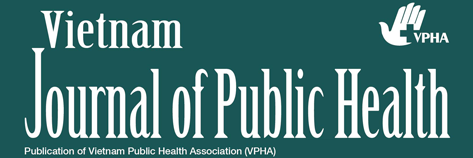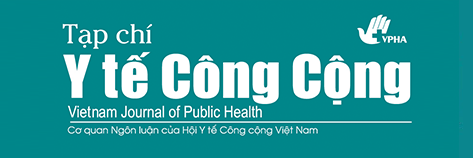Customers’s intention to consume healthier foods: apply of the theory of planned behaviour.
Abstract
Introduction: The purpose of this research was to investigate the associated factors of intention to consume healthier food among customers in 5 provinces, applying the theory of planned behaviour (TPB).
Methods: A cross-sectional study with face-to-face interviews using structured questionnaire among 1493 customers who were shopping at supermarkets and retail stores was conducted.
Results: Three factors were positively associated with “intention to consume healthier food in the coming time”, including “attitude toward consuming healthier foods” (b = 0.37), “subjective norm about consuming healthier food” (b = 0.31), and “perceived behaviour control of consuming healthier food” (b = 0.16). Attitudes toward consuming healthier foods were slightly more important than the subjective norm. Three factors explained 45,4% of the variance in behavioural intention.
Conclusion: The study findings support the theory of TBP’ predictions. Future efforts to comprehensively develop and implement interventions guided by the TPB hold promise for encouraging the intention to consume healthier foods.
Keywords
Full Text:
PDFReferences
World Health Organization. Global Status Report on Noncommunicable Diseases 2014.; 2014.
World Health Organization. Projections of Mortality and Causes of Death, 2015 and 2030.; 2019. Accessed March 3, 2019. https://www.who.int/healthinfo/global_burden_disease/projections/en/
World Health Organization. The Global Burden of Disease : 2004 Update. World Health Organization; 2008.
World Health Organization. Noncommunicable Diseases in the South-East Asia Region.; 2011.
Allender S, Lacey B, Webster P, et al. Level of urbanization and noncommunicable disease risk factors in Tamil Nadu, India. Bull World Health Organ. 2010;88(4):297-304. doi:10.2471/BLT.09.065847
Angkurawaranon C, Wattanatchariya N, Doyle P, Nitsch D. Urbanization and Non-communicable disease mortality in Thailand: an ecological correlation study. Trop Med Int Health. 2013;18(2):130-140. doi:10.1111/tmi.12038
Hancock C, Kingo L, Raynaud O. The private sector, international development and NCDs. Glob Health. 2011;7(1):23. doi:10.1186/1744-8603-7-23
World Health Organization. Total NCD deaths data by country. Published online March 3, 2019. Accessed March 3, 2019. http://www.who.int/gho/countries/vnm/en/.
World Health Organization. Global Status Report on Noncommunicable Diseases 2010.; 2010.
Ministry of Health. National Survey of Risk Factors of NCDs in Vietnam. Ministry of Health; 2016.
Bui TV, Blizzard CL, Luong KN, et al. National survey of risk factors for non-communicable disease in Vietnam: prevalence estimates and an assessment of their validity. BMC Public Health. 2016;16(1):498. doi:10.1186/s12889-016-3160-4
The Theory of Planned Behavior: A Review of Its Applications to Health-Related Behaviors. ResearchGate. Accessed October 4, 2020. https://www.researchgate.net/publication/13133717_The_Theory_of_Planned_Behavior_A_Review_of_Its_Applications_to_Health-Related_Behaviors
Ajzen I. The Theory of Planned Behavior. Organ Behav Hum Decis Process. 1991;50:179-211. doi:10.1016/0749-5978(91)90020-T
Alexandria Gabrielle Booker. Intentions to eat a healthy diet: applying the theory of planned behavior in an African American faith-based population. Published online 2016. Accessed October 4, 2020. https://mospace.umsystem.edu/xmlui/bitstream/handle/10355/58877/Thesis_2016_Booker.pdf?sequence=1&isAllowed=y
Vallerand R, Pelletier L, DESHAIES P, CUERRIER J, MONGEAU C. Ajzen and Fishbein theory of reasoned action as applied to moral behavior - a confirmatory analysis. J Pers Soc Psychol. 1992;62:98-109. doi:10.1037//0022-3514.62.1.98
Understanding Power and Rules of Thumb for Determining Sample Size. Accessed October 7, 2020. https://www.researchgate.net/publication/49619425_Understanding_Power_and_Rules_of_Thumb_for_Determining_Sample_Size
Green SB. How Many Subjects Does It Take To Do A Regression Analysis. Multivar Behav Res. 1991;26(3):499-510. doi:10.1207/s15327906mbr2603_7
Hardin-Fanning F, Gokun Y. Gender and age are associated with healthy food purchases via grocery voucher redemption. Rural Remote Health. 2014;14(3):2830.
Chambers S, Lobb A, Butler L, Traill W. The Influence of age and gender on food choice: a focus group exploration. Int J Consum Stud - Int J Consum Stud. 2008;32:356-365. doi:10.1111/j.1470-6431.2007.00642.x
Wu T, Jeromy P, Snider B, et al. Intention for Healthy Eating Among Southern Appalachian Teens.
Åstr⊘sm AN, Rise J. Young adults’ intention to eat healthy food: Extending the theory of planned behaviour. Psychol Health. 2001;16(2):223-237. doi:10.1080/08870440108405501
Golnaz Rezai. Consumers’ awareness and consumption intention towards green foods. Afr J Bus Manag. 2012;6(12). doi:10.5897/AJBM11.1414
Applying the Theory of Planned Behavior to Predict Dairy Product Consumption by Older Adults | Request PDF. ResearchGate. Accessed October 4, 2020. https://www.researchgate.net/publication/8988266_Applying_the_Theory_of_Planned_Behavior_to_Predict_Dairy_Product_Consumption_by_Older_Adults



